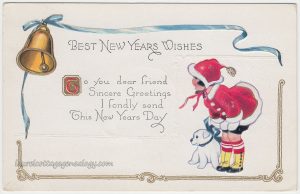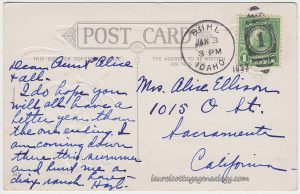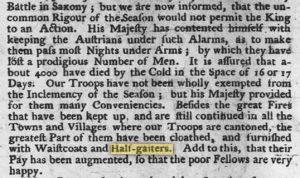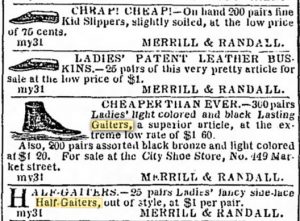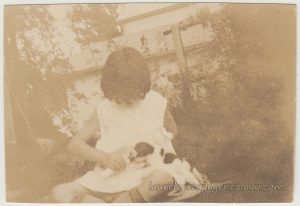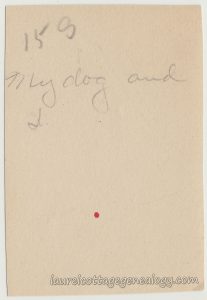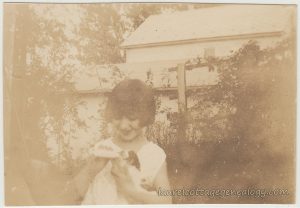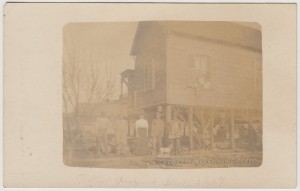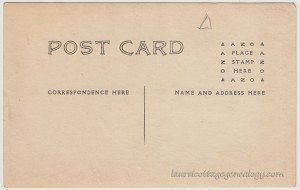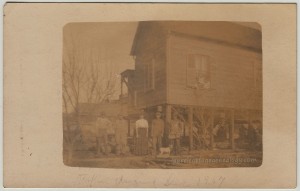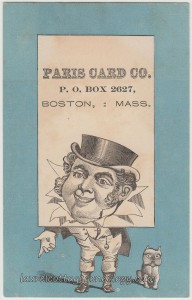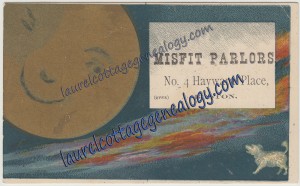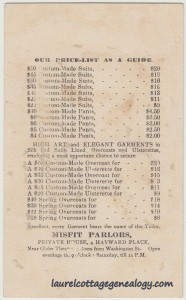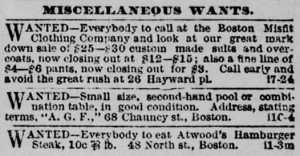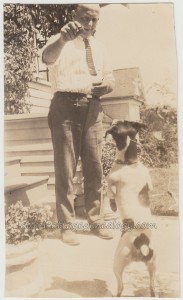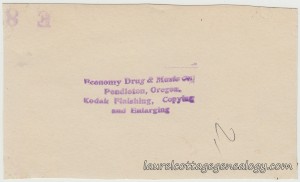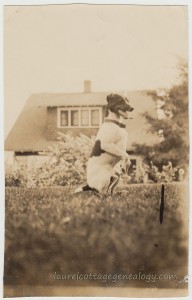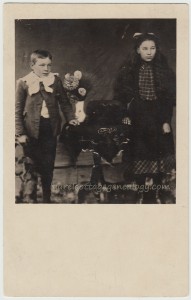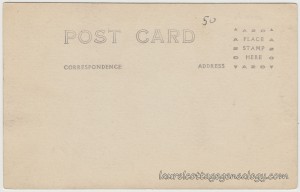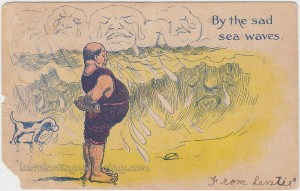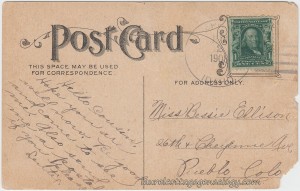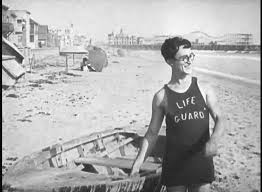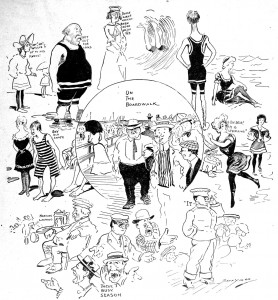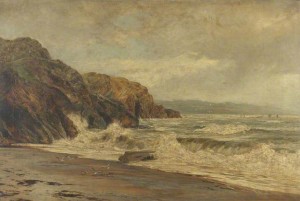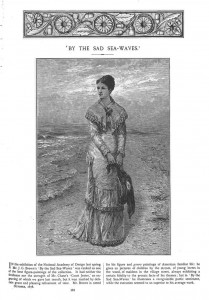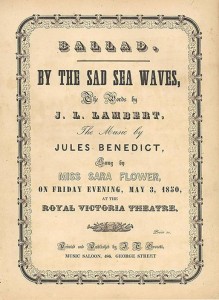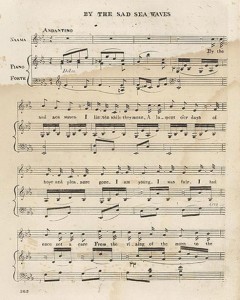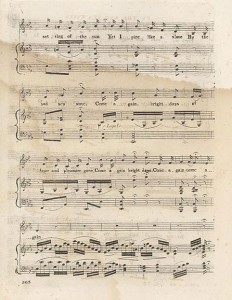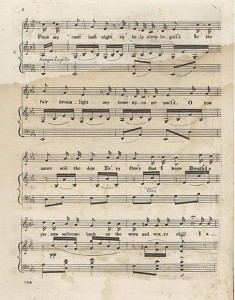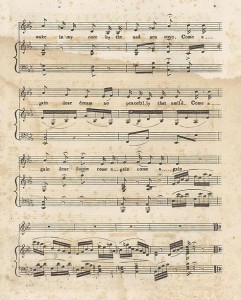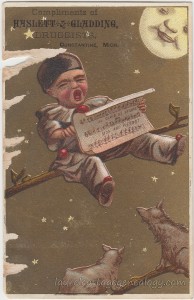
Trade card, circa 1875 – 1880. Size: About 4 and 1/2 x 3″
Price: $20.00
Here’s a beautiful and unusual old trade card. Too bad about the tears in the card on the left, but what an interesting one! The printing at the top shows “Compliments of Haslett & Gladding, Druggists, Constantine, Mich.” and the artwork shows a figure of a little man wearing what this web author first thought of as a Pagliacci style clown suit, sitting on a tree branch, singing a song from an opera. As always, the research for old trade cards illuminates a little bit of history, and informs the researcher. This little figure actually represents Pierrot, described in a Wikipedia entry as “…a stock character of pantomime and Commedia dell’Arte whose origins are in the late seventeenth-century Italian troupe of players performing in Paris and known as the Comédie-Italienne; the name is a hypocorism of Pierre (Peter), via the suffix -ot. His character in postmodern popular culture – in poetry, fiction, the visual arts, as well as works for the stage, screen, and concert hall – is that of the sad clown, pining for love of Columbine, who usually breaks his heart and leaves him for Harlequin.”
To finish describing the above card, Pierrot is singing with great emotion, and holding sheet music on which we can read the words au clair de la lune mon ami pierrot (in the moonlight my friend Pierrot.) A benevolent full moon, smiling down upon Pierrot, appears in the top right corner. The background is gold tone with white stars, but what seems most unusual and somewhat perplexing are the two dog-like animals perched on the branch below our subject. Dogs in trees?
As for the “opera” – the sheet music turns out to be actually that of the classic french children’s song Au clair de la lune. Author unknown, and dating from at least back to the mid-18th century, this song made history in 2008, when the first known recording of the human voice was digitized, and it was detected that what was being heard was a couple of lines from this folk song. The ten-second snippet was recorded in 1860 by Parisian inventor Édouard-Léon Scott de Martinville using a device called a phonautograph, and pre-dates Thomas Edison’s recording of “Mary Had a Little Lamb” by seventeen years. From an article by Jason Dearen of the Associated Press, “Using a needle that moved in response to sound, the phonautograph etched sound waves into paper coated with soot from an oil lamp.” “Au Clair de la Lune” and other recordings were discovered by audio historian David Giovannoni and his research partner Patrick Feaster in France’s patent office. Earliest Known Voice Recording Discovered in France.
Getting back to the question of the two animals perched on the lower tree branch: I thought at first that they might be lynxes, after coming across the image below just a few days after getting the trade card. This drawing was done by New York artist Edmund Henry Garrett (1853 – 1929.) And it depends upon how you look at the animal on the right in the top image – that appears to be his left ear rather than snout. If you view the ear as a snout then Pierrot’s animal friends might appear to be more coyote-like, but look again and you’ll probably decide that that is not the animal’s profile that we’re looking at, in which case the lynx idea doesn’t fit. Of course, they may have just been something created from the artist’s imagination….To be treed by lynxes though, what an unusual subject, so I just thought it would be fun to include this here.
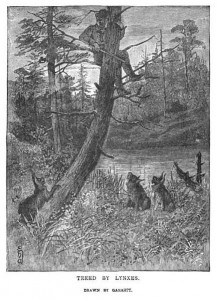
Last but not least, Haslett & Gladding Druggists show up in Polk’s city directories for Constantine, Michigan for 1875 and 1877. The 1877 directory shows that they were Charles M. Haslett and Benjamin O. Gladding. As of the the date of this post, no other trade cards were found online for them.
Charles McLean Haslett was born in New York, December 8, 1846, son of Peter and Helen Haslett. (The christening and birth record does not state his mother’s maiden name.) He married Charlotte E. Knowlen January 25, 1870. The 1870 Federal Census for Constantine shows the newlyweds living with Charles’ parents. His occupation is retail druggist. Sadly, Charles died young at the age of 40, May 24, 1887, in Detroit.
Benjamin O. Gladding was born in Michigan, August 5, 1847, son of John Gladding and Martha E. Howard. The 1850 Federal Census for Constantine shows Benjamin, his parents and his two older sisters, Emily and Jerusha Gladding. Also in the household is 18-year old Elisabeth Churchill[?], possibly a boarder or domestic servant. Benjamin married Louisa Lantz, born Pennsylvania, April 30, 1849. (Louisa is “H. Louisa” on a couple of her census records.) The 1880 census for Constantine shows Benjamin and Louisa, and their children, William O., age five, and Mary L., eight months. Benjamin’s occupation is druggist. Find A Grave shows the death year for Benjamin as 1919.
Sources: Pagliacci. n.d. http://en.wikipedia.org/wiki/Pagliacci. (accessed September 23, 2014.)
Pierrot. n.d. http://en.wikipedia.org/wiki/Pierrot. (accessed September 23, 2014.)
Romer, Megan, “Au Clair de la Lune Lyrics and Translation,” About.com. http://worldmusic.about.com/od/instrumentation/a/AuClairdelaLune.htm. (accessed September 24, 2014.)
Dearen, Jason, “Earliest Known Voice Recording Discovered in France.” Associated Press (March 28, 2008.) Web article from National Geographic News (October 28, 2010.) http://news.nationalgeographic.com/news/2008/03/080328-AP-earliest-re.html (accessed September 24, 2014.)
Garrett, Edmund H., Treed By Lynxes. American Art and American Art Collections. Ed. Walter Montgomery. Boston: E. W. Walker & Co., 1889. p. 266. (Google eBooks.)
Edmund H. Garrett. n.d. http://en.wikipedia.org/wiki/Edmund_H._Garrett. (accessed September 23, 2014.)
R. L. Polk & Co.,’s Michigan State Gazetteer and Business Directory. 1875, p. 195 and 1877, Vol. III. p. 231. (Google eBooks.)
“New York, Births and Christenings, 1640-1962,” index, FamilySearch (https://familysearch.org/pal:/MM9.1.1/FDTF-RMQ : accessed 26 Sep 2014), Charles Mc Lean Haslett, 08 Dec 1846; citing , reference ; FHL microfilm 363878.
Year: 1860; Census Place: Constantine, St Joseph, Michigan; Roll: M653_561; Page: 355; Image: 365; Family History Library Film: 803561. (Ancestry.com)
“Michigan, Marriages, 1868-1925,” index and images, FamilySearch (https://familysearch.org/pal:/MM9.1.1/N3KK-TM5 : accessed 27 Sep 2014), Chas. W. L. Haslet and Charlotte E. Knowlen, 25 Jan 1870; citing Constantine, St Joseph, Michigan, v 3 p 210 rn 59, Department of Vital Records, Lansing; FHL microfilm 2342452.
Year: 1870; Census Place: Constantine, St Joseph, Michigan; Roll: M593_700; Page: 63B; Image: 130; Family History Library Film: 552199. (Ancestry.com)
Ancestry.com. Michigan, Deaths and Burials Index, 1867-1995 [database on-line]. Provo, UT, USA: Ancestry.com Operations, Inc., 2011.
Year: 1850; Census Place: Constantine, St Joseph, Michigan; Roll: M432_362; Page: 295A; Image: 365. (Ancestry.com)
“Michigan, County Marriages, 1820-1935,” index and images, FamilySearch (https://familysearch.org/pal:/MM9.1.1/VNLS-J18 : accessed 27 Sep 2014), John P Gladding and Martha E Howard, 10 Oct 1839; citing p. 132, St. Joseph, Michigan; FHL microfilm 1295528.
“Michigan, Marriages, 1868-1925,” index and images, FamilySearch (https://familysearch.org/pal:/MM9.1.1/N3X1-LHY : accessed 27 Sep 2014), Louisa Lantz in entry for Wm. O. Gladding and Clara H. Cummings, 20 Sep 1898; citing Centerville, St Joseph, Michigan, v 4 p 269 rn 2516, Department of Vital Records, Lansing; FHL microfilm 2342510.
Year: 1880; Census Place: Constantine, St Joseph, Michigan; Roll: 603; Family History Film: 1254603; Page: 292A; Enumeration District: 191; Image: 0239. (Ancestry.com)
Year: 1900; Census Place: Chicago Ward 35, Cook, Illinois; Roll: 291; Page: 11B; Enumeration District: 1134; FHL microfilm: 1240291. (Ancestry.com)
Find A Grave Memorial# 75381891 (Findagrave.com)

